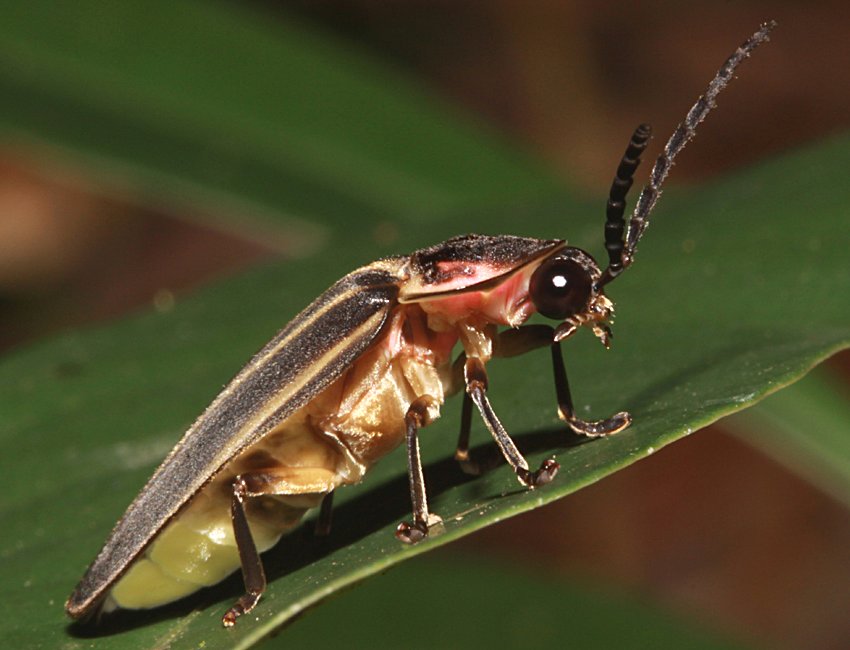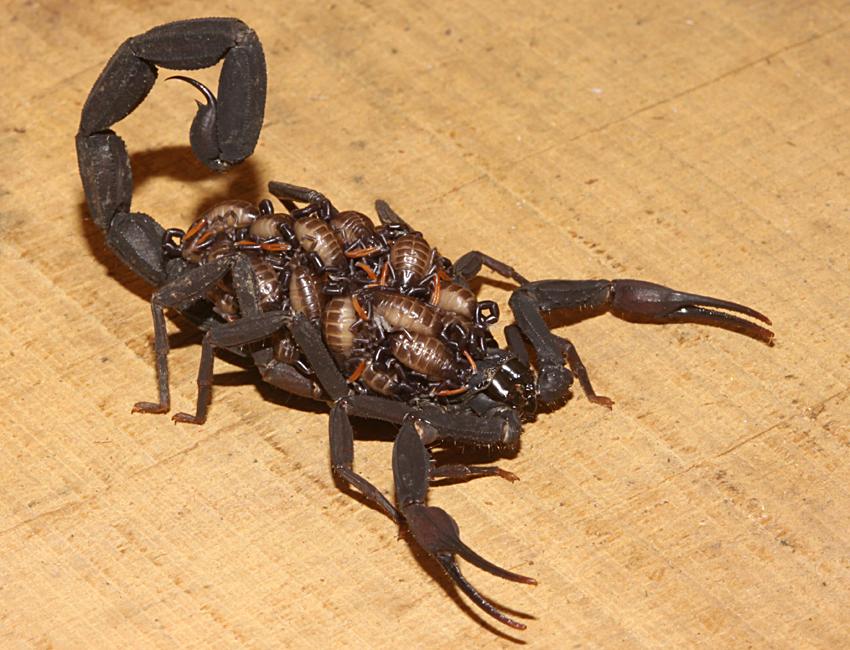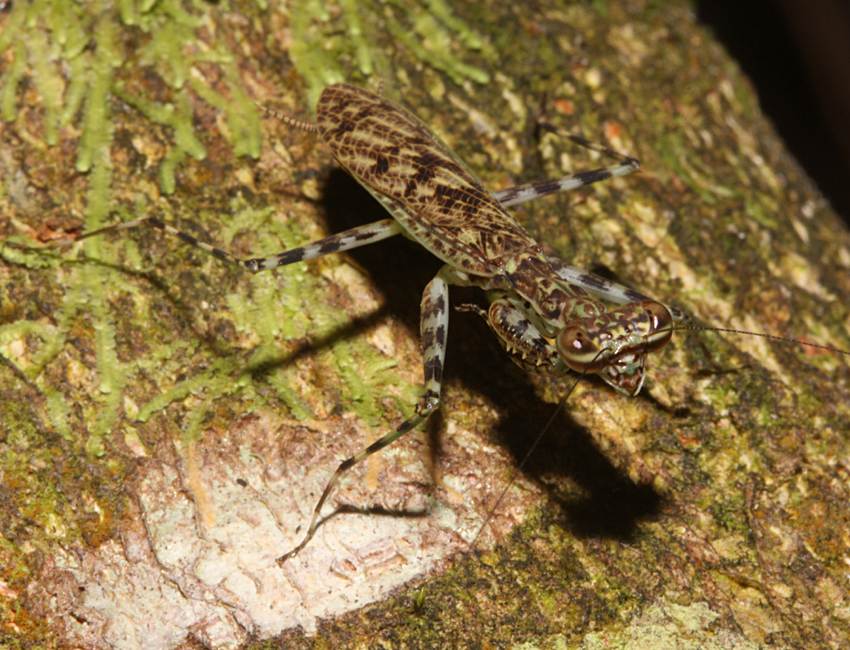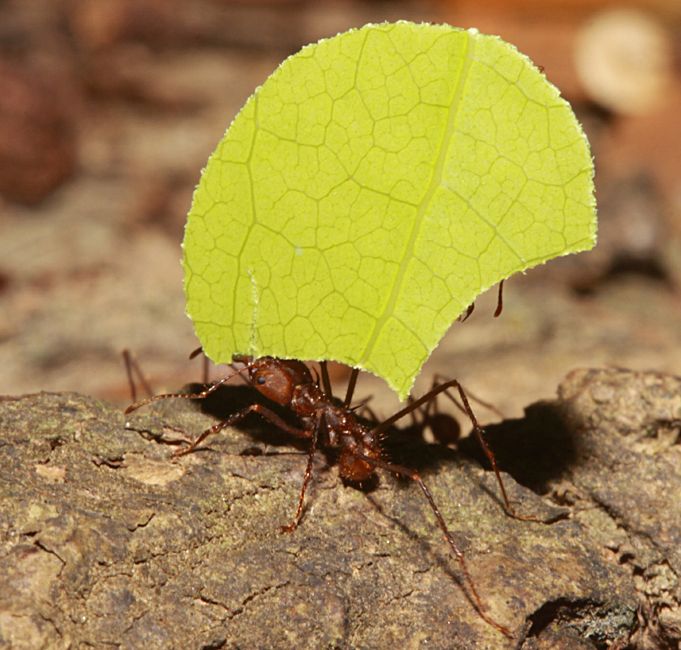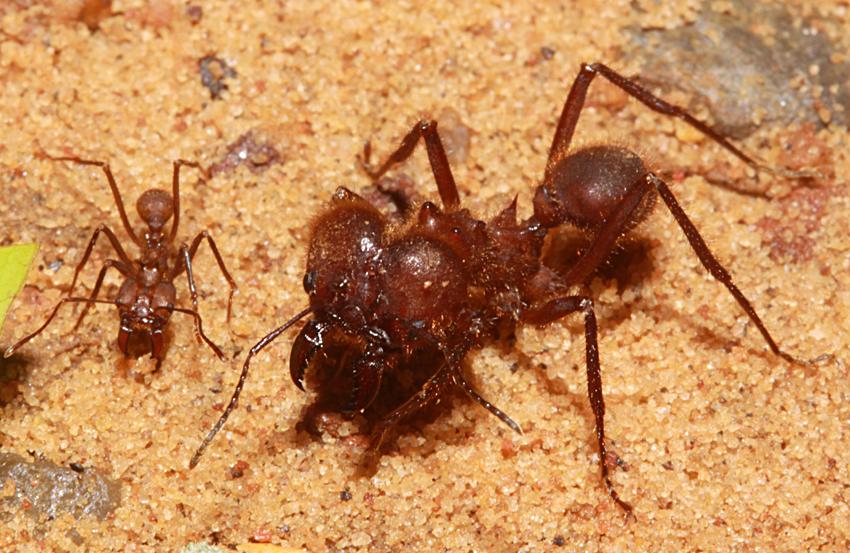Bugs of Belize
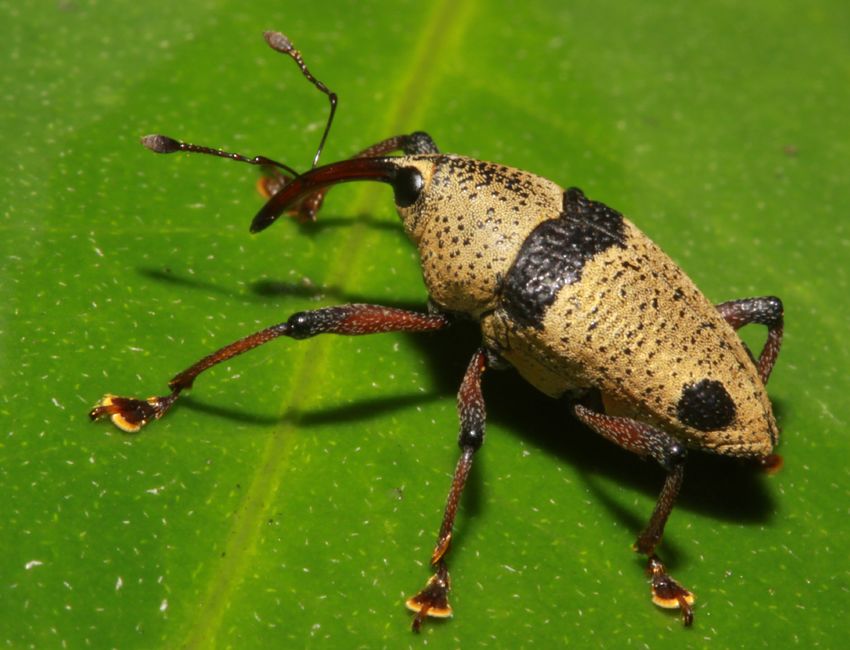
This comical looking insect with antennae poking out halfway along its long mouthparts is a type of beetle called a weevil, photographed in the Cockscomb jaguar reserve. There are more insects in the world than any other type of animal, more beetles in the world than any other type of insect, and more weevils in the world than any other type of beetle. About 40% of the 900000 known insect species are beetles, and there are about 60000 species of weevils, making them more numerous than any other order of animal. By comparison there are only 28000 fish, 10000 birds, 8200 reptiles and 5400 mammals. |
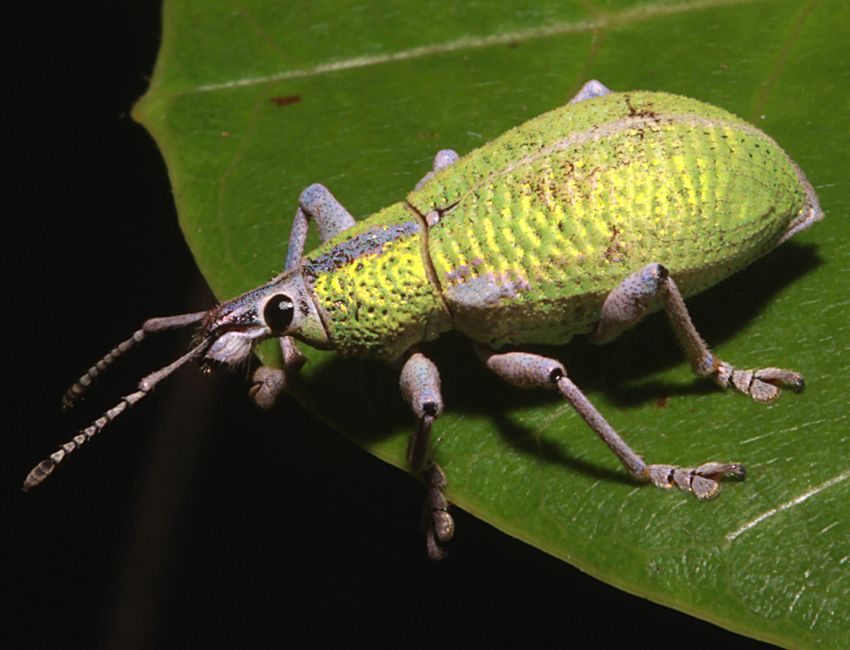
Here's another weevil. Weevils like this one are very unusual amongst insects because they can swivel their heads around in a circle. Most insects cannot move their heads at all, or can only move them a small amount. The mouth is at the end of the long "snout", and together with those antennae and the protruding eyes, it gives this insect quite a comical appearance. We can learn many things from the natural world, and one of the most important lessons you can learn in life is that if you ever find a pair of weevils together, whether of the same species or two different species, then you should always choose the lesser of the two weevils. |

A beetle prepares to launch itself into flight in Cockscomb national park. Beetles comprise an order of insects with the name Coleoptera, a Greek word which means "sheathed wings". The front pair of wings has become hard and is no longer used for flying, instead being used as a cover for the rear wings, which generate all the lift for flight. This protects the wings and body, but at a cost. The front wings, or elytra, have to be held out of the way during flight and act as drag, making it harder to fly. The rear wings have to be folded and unfolded for flight, which can be a very complicated and lengthy exercise, sometimes requiring the beetle to use its feet and abdomen to make it happen. This procedure also makes it much harder for the beetle to escape quickly when threatened. |

And here's one of those click beetles, in Rio Blanco national park in the far south of the country. It's holding on to a stick with just one pair of legs because it knows that I'm there but it's not sure whether to pretend to be dead, or not. These bioluminescent click beetles belong to the genus Pyrophorus, which literally means "fire carrying", and refers to the two light colored spots on its back which produce light just like a firefly, except that the light is continuous rather than flashing. The night this click beetle was photographed, there were both fireflies and click beetles illuminating the forest. The shape of this beetle is very characteristic of the world's 9300 click beetles, a family which are also sometimes known as "skipjacks" or "spring beetles". The front and back parts of the body, clearly visible in this photo, work together to produce the "click" for which these beetles are named. The beetle moves a spine on the front of the body into a notch on the back of the body and this both propels the beetle into the air and makes a loud click. The easiest way to experience this is to gently hold the beetle between your thumb and forefinger, which will make it perform its party trick. |

This large and spectacular gold-colored darkling beetle was wandering around at night in the same patch of forest as the bioluminescent click beetle. |
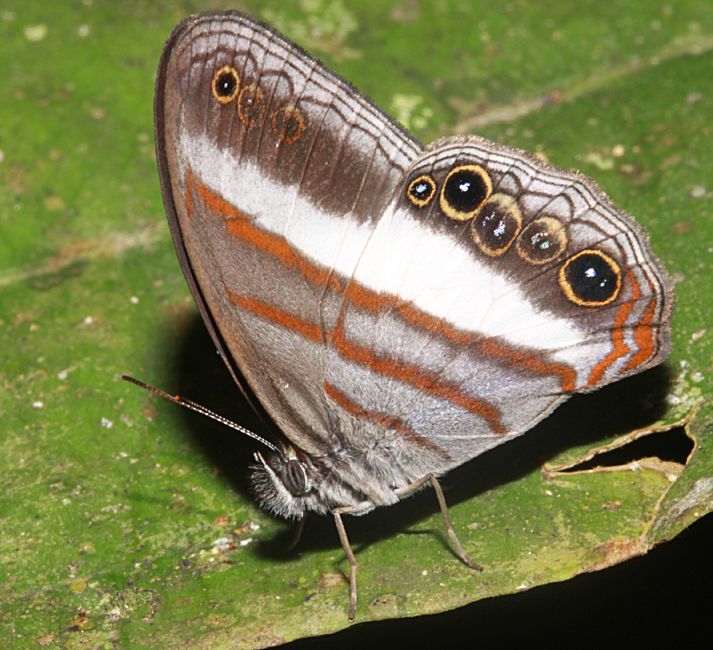
This two-banded satyr (Pareuptychia ocirrhoe) belongs to a butterfly sub-family known as "satyrs" or "browns". With about 2400 members this sub-family comprises about half of the brush-footed butterflies (Nymphalidae). As with many members of that family, this satyr has only four functional legs. Satyrs like this one often have eye-spots on their wings, but species living in temperate regions are usually quite dully colored. |
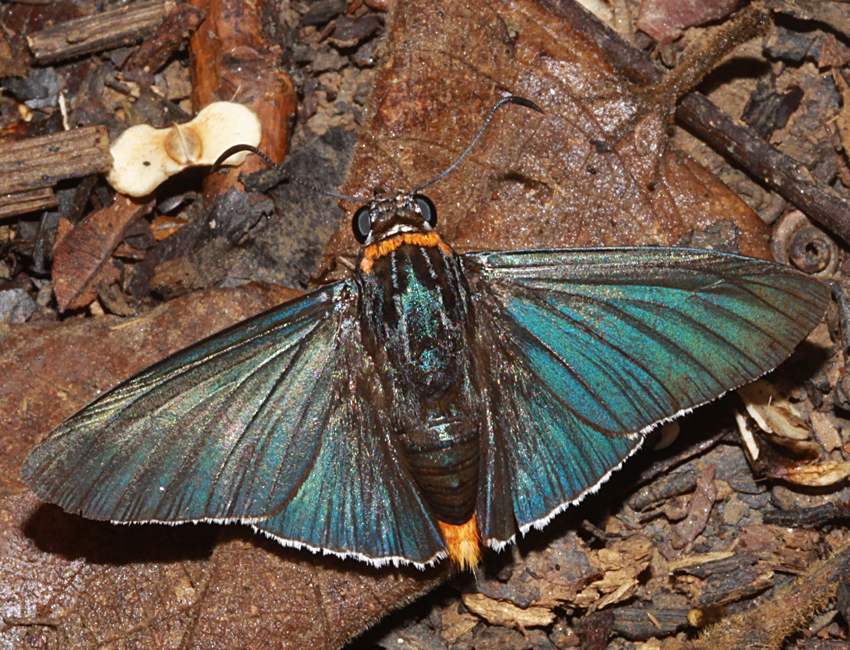
It took me quite a bit of patient stalking to capture this photo of a firetip skipper butterfly in the Cockscomb Basin jaguar reserve. This skipper is unusual in a number of ways. The coloration isn't typical for a skipper, its wing shape is peculiar and it's resting with its wings open - common for many butterflies, but not for skippers. Finally, as it flew up and down the trail it made a loud whirring noise like a large bee or beetle. This one looks like a real speedster, which is appropriate since skippers are the fastest-flying of all butterflies, achieving speeds of up to 35 miles per hour. |
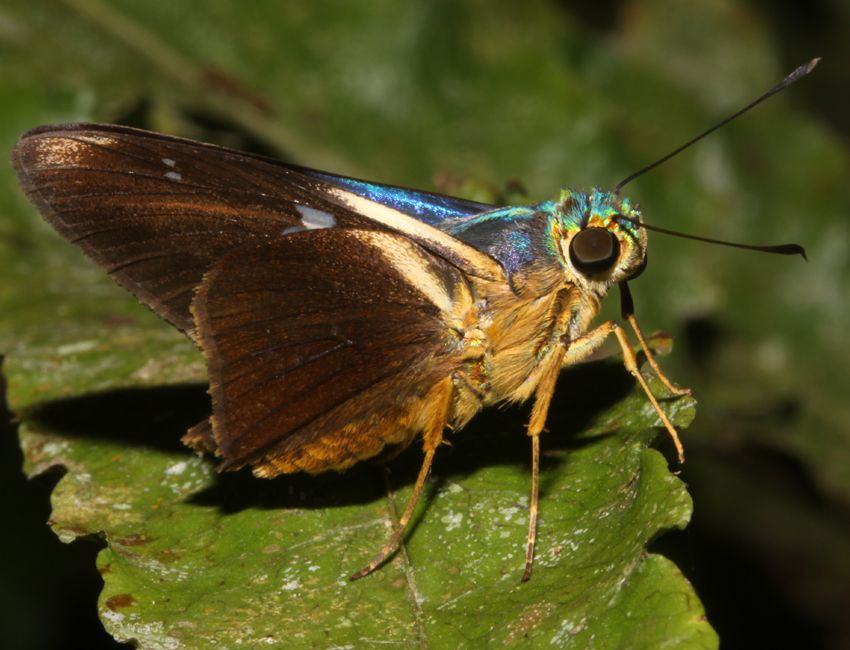
This beautiful iridescent butterfly photographed on the path up to the Bocawina Falls is another type of skipper. Most skippers in temperate parts of the world are a dull brown or yellowish color, but many of the tropical varieties have iridescent scales on their wings and bodies. Up at the Bocawina Falls I found one of the clear-winged butterflies which live in Central and South America. Unfortunately, I couldn't get close enough to take a photo, even after chasing it around for 15 or 20 minutes. |
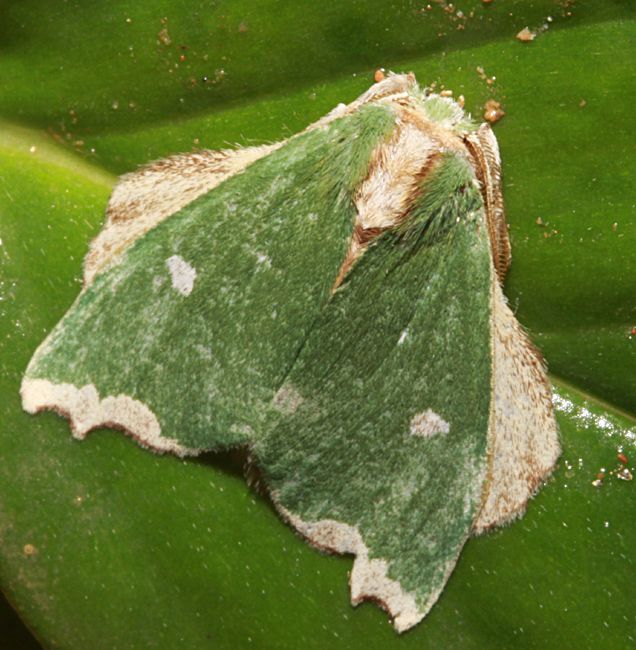
This well camouflaged moth was on one of the paths in the Cockscomb Basin nature reserve. It's very small, and I suspect it belongs to the Geometrid moth family, whose caterpillars are better known as inchworms. |
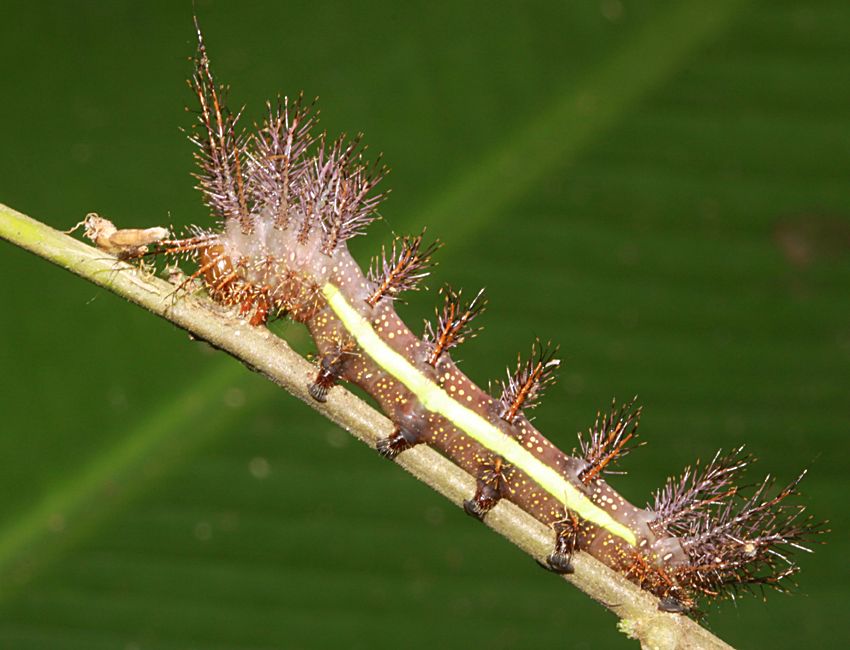
This very spiky caterpillar was living near Monkey River. |

Another caterpillar, but not in such good shape as the last one! Ants and wasps frequently attack caterpillars, but this is the first time I can remember seeing a spider like this jumping spider eating one. |
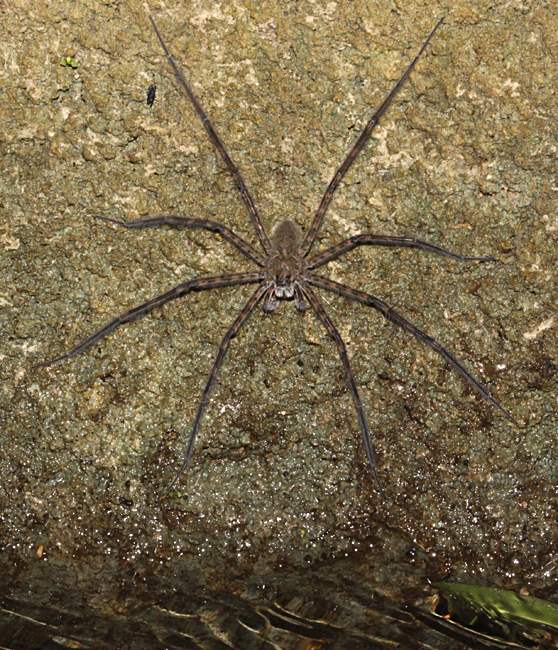
Here's a fishing spider next to the Rio Blanco river, just above the waterfall at Rio Blanco national park. Normally, fishing spiders stand on the water with only their hind pair of legs anchored to the shore, but this one might be on land because it's detected my presence, or because the water is flowing very rapidly. As their name suggests, fishing spiders hunt in water, taking other bugs which have fallen in, or even catching tadpoles or very small fish under the water. They detect the ripples made by their prey, and then go out on the surface of the water to capture it, using small hooks on their front legs. They usually attach a silk safety line to the shore to prevent themselves from being carried away by any current. When they crawl underwater their bodies are surrounded by a thin, silvery pocket of air, which allows them to continue breathing. They're covered with hairs which repel water, so when they resurface they're completely dry. Being in the open makes spiders very vulnerable to predators, so the hundred or so species of fishing spider found around the world are nocturnal hunters. They have hairs on their legs which are very sensitive to vibration, allowing the spiders to distinguish struggling insects or moving aquatic animals from waves generated by the wind or by the flowing water. They can even work out how far away their prey is, and in what direction. |
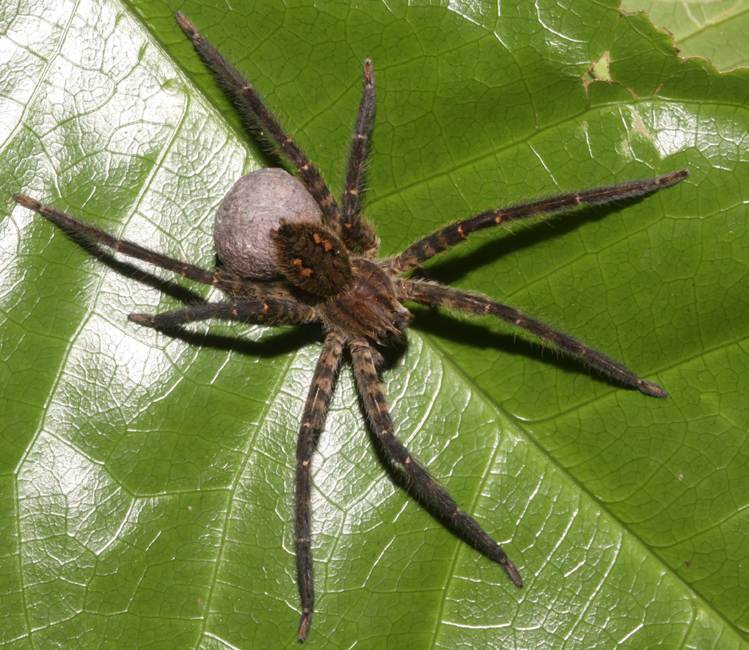
A female wolf spider carries her egg sac around with her as she hunts on the forest floor. Some mobile spiders attach their eggs to their fangs or pedipalps, but wolf spiders attach the sac to the spinneret they use to produce silk. After the eggs hatch, the mother spider will carry her babies around on her back until they molt. Like jumping spiders, most wolf spiders wander around and hunt, rather than relying on a web to trap prey. Both types of spider hunt mainly by sight, unlike other spiders which rely on their sense of feel to detect vibrations in the web or the nearby area. |

A Mexican redrump tarantula waits for a meal at night on the forest floor. The hairs on its body are used as a defense. If a predator like a coatimundi takes too much of an interest in the spider, it uses its back legs to break off the hairs, which then float in the air and become lodged in the predator's eyes and nose. They're called "urticating" hairs after the Latin word for nettles, and like nettles they cause a very unpleasant reaction which is normally enough to drive the attacker away. The effects can often linger for a year or more, so owners of pet tarantulas are advised to be very careful when handling them. |
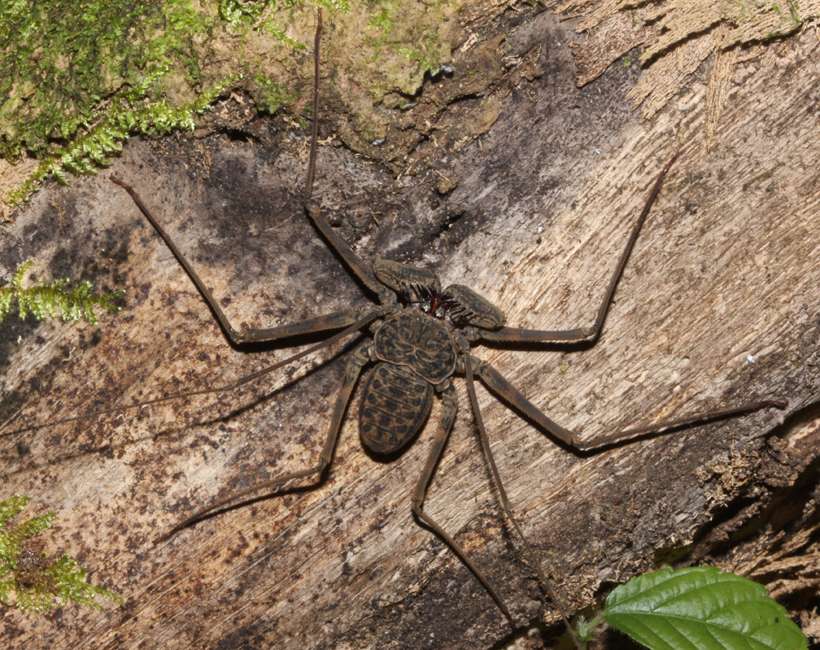
This tail-less whip scorpion is another type of arachnid. Although it looks very intimidating, it's actually harmless, and unlike the scorpion it doesn't have any venom. About 140 species are known now, but it's an ancient type of bug, dating back to the Carboniferous period, over 300 million years ago. The long "antennae" are actually the first pair of legs, which have become extremely thin, very long, and covered with sensory receptors. As they walk, they hold one of these long feelers in front of them, and one out to the side, in order to detect whatever is out there. If they touch a prey item with one of these feelers, they capture it with the large spiky pedipalps at the front of their body. |
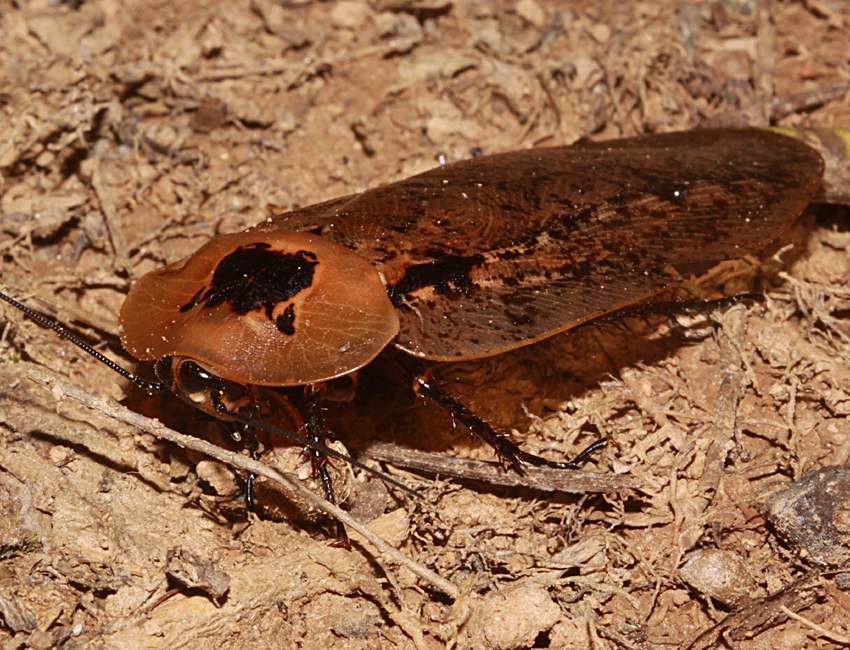
This peppered roach (Archimandrita tesselata) wasn't too happy being photographed, it wouldn't keep still for more than a few seconds at a time. This is one of the larger cockroach species, reaching 7 centimeters in length. Although it has wings, they avoid flying. Like the great majority of the world's cockroaches, it prefers to make its living in the leaf litter of the forest, rather than in people's houses. When it's in its natural habitat it's fairly difficult to spot because it looks like a large leaf which has died and fallen on the ground. |
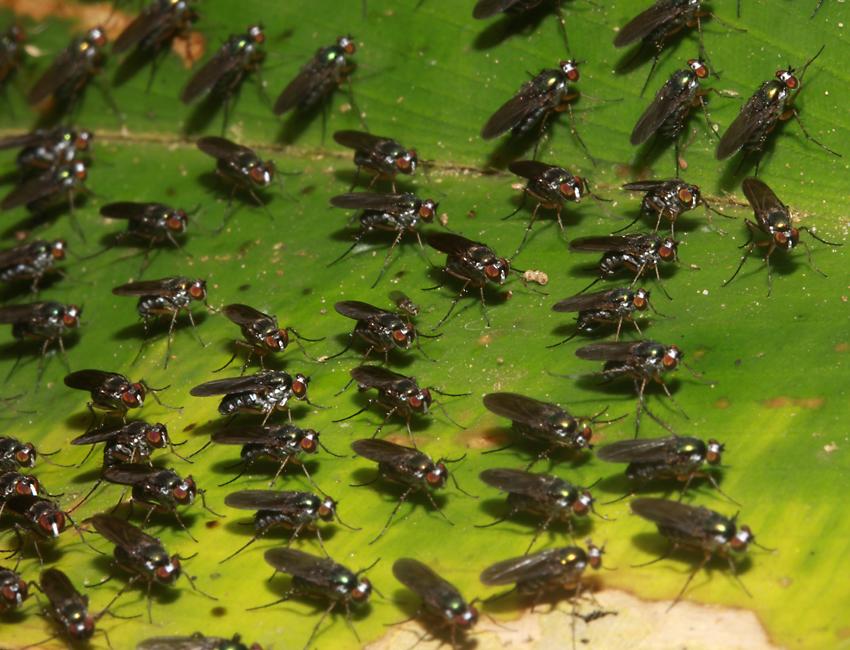
Creepy! This looks like a scene from a horror movie like Hitchcock's "The Birds", but transposed down to the level of bugs. These flies were actually roosting together at night in Cockscomb nature reserve. |
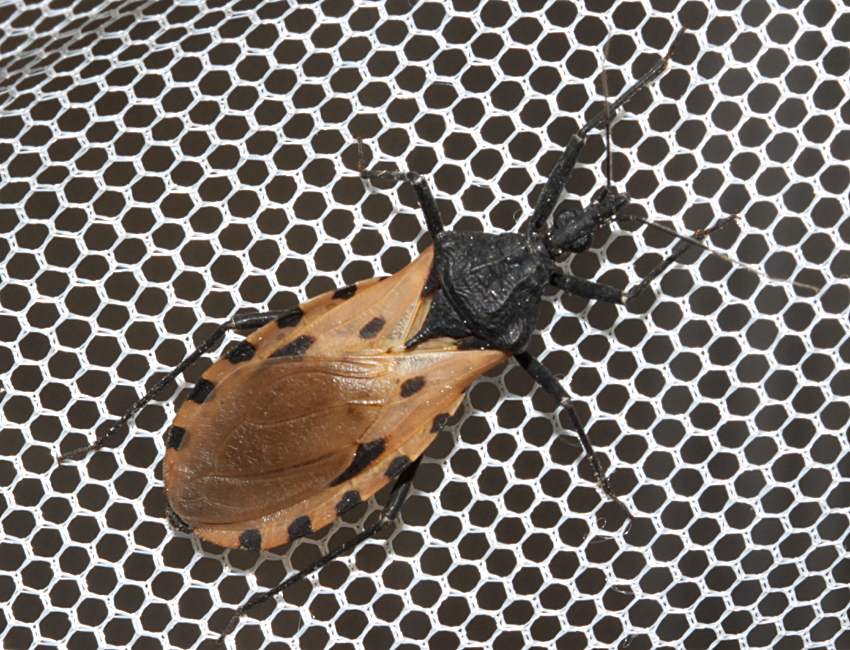
This is one of the most dangerous insects known to man, probably second only to the mosquito in the number of people it has killed. This is a kissing bug (Triatoma sp.), and it's sitting above an insect net spread over my bed in Rio Blanco national park, in the far south of Belize. They can be found throughout Latin America, and all the way up into the southern states of the USA. They get their name from their habit of biting people on the face as they sleep, sucking up the fluids just like a mosquito. Unfortunately, just as mosquitos sometimes carry a parasite which causes malaria, so kissing bugs also sometimes carry a parasite which causes Chagas disease. The malaria parasites enter the body as the mosquito is drinking blood, but the Chagas disease parasite isn't transmitted this way by the kissing bug. Instead, after its meal the kissing bug defecates and it's when a person unknowingly rubs the faeces into the wound or into an eye that the parasite enters the body. Malaria usually isn't fatal, but the parasites which cause Chagas disease very slowly eat into the person's body and destroy vital organs like the heart and the digestive tract. There are treatments available for malaria, but nothing works well with Chagas disease and eventually the victim will die, often not knowing that they're infected. |
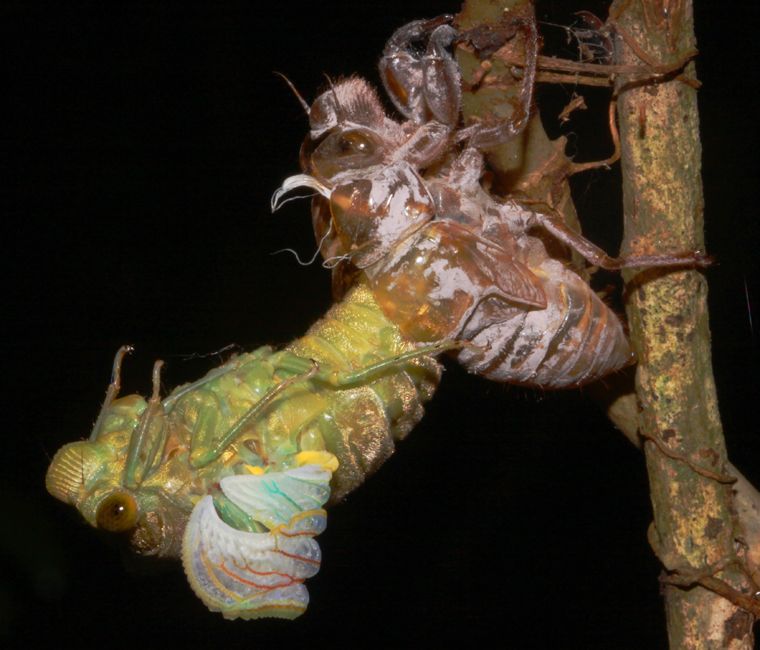
Under cover of darkness a cicada emerges from its old exoskeleton and takes on its new form as a winged insect. Like the kissing bug, cicadas are a type of "true bug", all of which use a straw-like mouthpiece called a "rostrum" to feed. In the case of the cicada, most of its life is spent underground, sucking sap from the roots of a tree or other plant. They leave this sheltered existence only to mate and reproduce, after which they soon die. |

The cicada wasn't the only insect taking advantage of the darkness to metamorphize into a new adult shape. Dragonflies and damselflies spend the early part of their lives underwater as voracious predators eating other bugs and even small fish and tadpoles. This photo, taken at night in Rio Blanco national park in Belize, shows a newly emerged dragonfly which is standing on the moulted shell of the aquatic animal it used to be. It has spread its wings and is waiting for them to dry and harden, so it can start its aerial life when the sun comes up. Emergence is a dangerous time for dragonflies because there are many things which can go wrong while it is getting its wings ready for flight. If it's very windy or it rains hard then the soft wings can be damaged and the dragonfly will be unable to fly, making it an easy meal at dawn for any bird which finds it. Most dragonflies develop their color over a period of time, so this dull-looking newly emerged individual might end up bright red or green. |
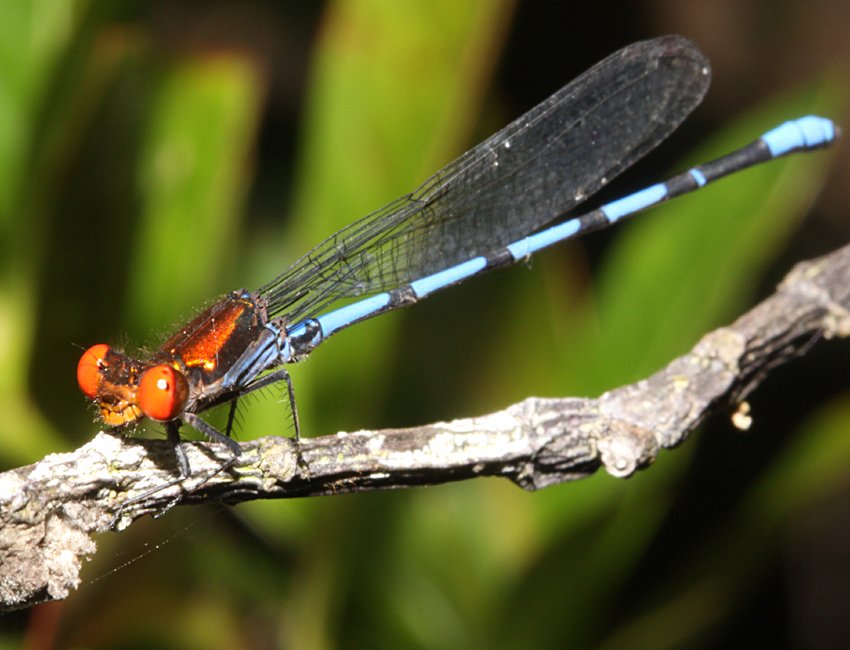
Damselflies are very closely related to dragonflies, and this one was also located within 100 meters of the dragonfly in the previous photo. However, since it's an adult, it was active during the daytime rather than the nighttime. This combination of colors is unusual for a dragonfly or a damselfly, though I did find a beautifully-named damselfly called the orange-tailed marsh dart in Cambodia, whose tail is orange and whose eyes are blue - just the opposite of this one's pattern! |
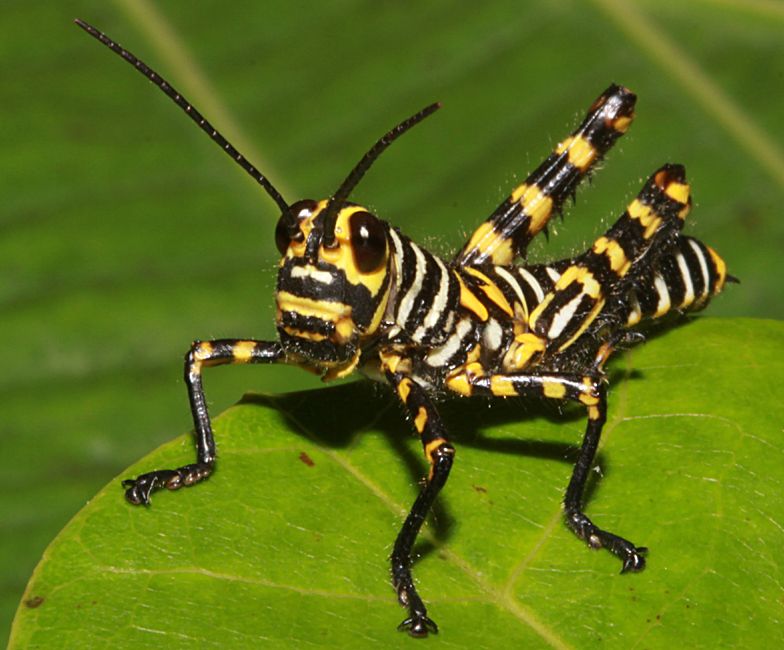
Juveniles of the giant red-winged grasshopper (Tropidacris cristata) like this one usually gather together in groups and this, together with their bright colors, suggests that they're toxic. If an inexperienced predator does eat one of them then it will quickly learn its lesson and avoid all animals with this color pattern, including the other ones in the immediate vicinity. This is an example of aposematic coloration as a defense mechanism, a very common occurrence in nature. Tasting bad sometimes just isn't enough, so like many other grasshoppers this one has sharp spines on its back legs. The grasshopper will use its powerful hind legs to kick any predator which comes too close, hopefully inflicting enough pain or damage to chase it away. As its name suggests, this is one of the largest of all grasshoppers, reaching 16 centimeters in length. It's possible that only the juveniles are chemically protected, since the adult lacks the black and yellow warning colors and looks like a totally different species. |
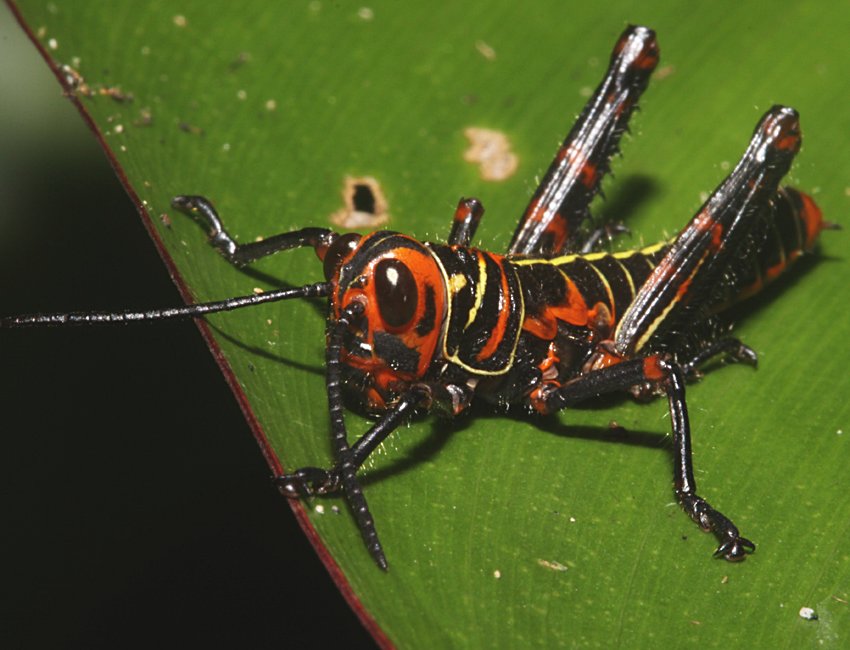
Here's another very colorful grasshopper. At first glance it certainly seems as if this is a different species than the previous photo, but the black striping is very similar, and it's not impossible that it's just at a different stage of the life-cycle, and that after moulting it will lose the red coloration and the yellow will become dominant. |
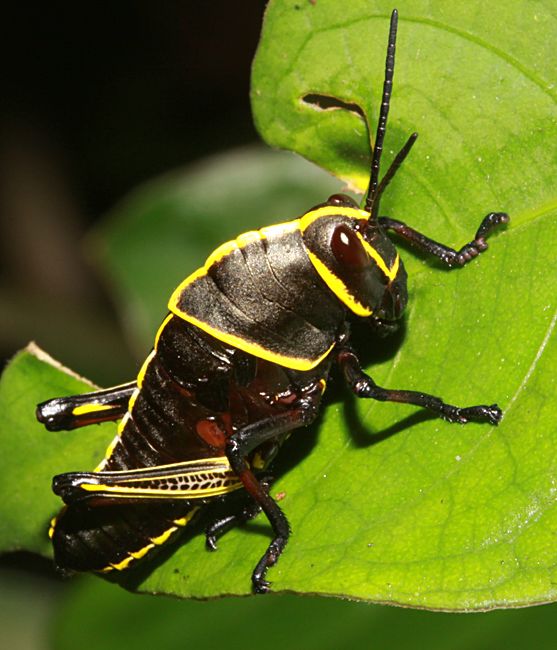
This horse lubber grasshopper (Taeniopoda eques) is definitely a different species! The Latin word "eques" means "horse", and was given to this species because the yellow marks on its head make it look a little like a horse with a bridle. This one can be recognized as a juvenile, because it lacks the yellow-veined wings of the adult. Adult females have wings, but they're too small to carry the bug's weight, so only the adult male can fly. In the United States and Mexico this species is found in deserts, but this one was in jungle. They sometimes occur in huge numbers, and they'll eat whatever plant life is in the area, as well as other animals, carrion and even each other! The lubbers are a whole family of large grasshoppers which are chemically protected. Not only do they taste bad, but they can also emit a smelly foam out of the breathing holes along the sides of their bodies. They can reach over 6 centimeters in length, though this one was much smaller than that. It's surprising how many attractive grasshoppers there are in the tropics, you can see a spectacular one from Cambodia called the northern spotted grasshopper. |

A mating pair of stick insects in Cockscomb Jaguar Reserve in Belize. Some species of stick insect breed by parthenogenesis, which means that the females don't require a male - however the male clinging to this one's back makes it obvious that this isn't one of those species! As with most of these insects, the female is much larger than the male. After mating she will lay her eggs, which often look like seeds, and when they hatch the babies will closely resemble the adults. |
